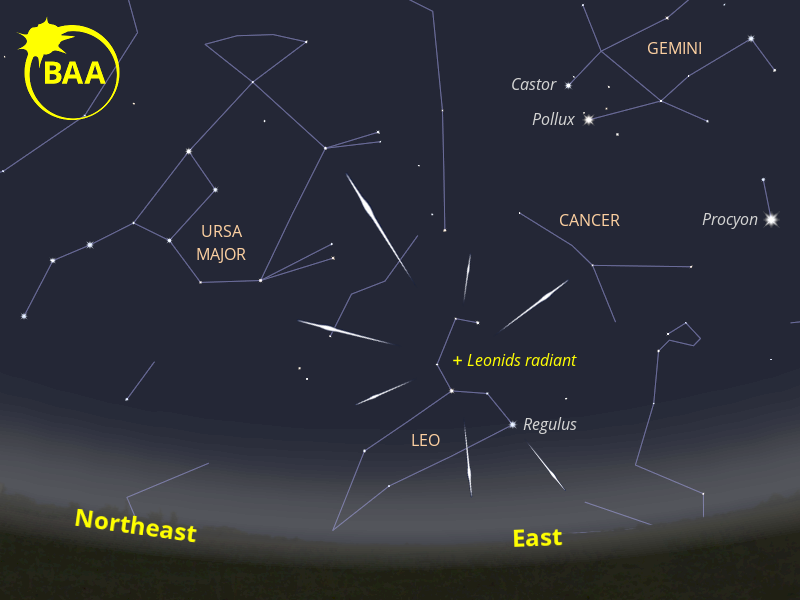2020 November 16
A chance to spot some Leonid meteors

With New Moon occurring on November 15th, the coming week presents a great opportunity to observe members of the Leonid meteor shower in dark, moonless skies. The shower is visible between about November 14 and 20 every year and peak activity currently occurs on November 17-18, at solar longitude (2000.0) 236°.0, which this year means that the early morning hours of Wednesday, November 18 should see the best rates.
Leonid meteors are exceptionally swift, having a very high geocentric velocity of 71 kilometres per second, with a high percentage leaving persistent trains. The radiant of the shower is situated at R.A. 10h 17m, Dec. +21°.4 (J2000.0), within the ‘Sickle’ of the constellation Leo. The radiant doesn’t rise until after 2300 hours so watches should ideally be made after midnight and the highest rates will be seen in the pre-dawn hours.
Some Leonid meteors are seen every year, with normal maximum rates of 5-20 meteors per hour (m/h) – which is probably what we can expect this year – and occasionally 20-50 per hour (m/h). However, the shower is most famous for the periods of enhanced activity that have, with a few exceptions, occurred at intervals of about 33 years. These are normally associated with the returns to perihelion of the parent of the Leonid stream, periodic comet 55P/Tempel-Tuttle, which has a period of 33.2 years.
The enhanced activity, which is caused by a dense swarm of dust particles in the vicinity of the parent comet, may extend from two years before to several years after the comet’s perihelion passage. At such times, the Leonid shower has produced some of the most remarkable displays to have been visible during the past 1000 years, with peak observed rates of many thousands of meteors per hour.
However, these great meteor storms do not occur unfailingly every 33 years due to the influence of planetary perturbations on the orbit of the Leonid stream, and the uneven dust distribution near to the parent comet. When comet 55P/TempelTuttle last returned to perihelion on 1998 February 28, there was considerably increased Leonid activity during the period from 1997 to 2006.
There may not be high rates this year, but it is always worth keeping a look out in case there is brief period of enhanced activity. If you cannot stay up all night, just set your alarm for about 0300 hours and watch until dawn twilight interferes. Don’t forget that some Leonids will be seen even on nights away from the maximum.
By whatever means you observe the Leonids this year, please submit your results to the BAA Meteor Section via meteor@britastro.org.
| The British Astronomical Association supports amateur astronomers around the UK and the rest of the world. Find out more about the BAA or join us. |
